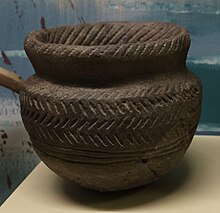
Peterborough ware is a decorated British Neolithic pottery style of the early to middle English Neolithic. Named after Peterborough, the nearest city to where the style was first discovered, it is found in the region of South-East England and East Anglia. it is known for the impressed pits made by bone or wood implements in its sides. Whipped cord was also used to make circular 'maggot' patterns. Ebbsfleeet ware, Fengate ware and Mortlake ware have been identified as subdivisions of Peterborough ware.
The term was introduced by R.A. Smith based on examples found at Fengate, near Peterborough. It originally referred to all neolithic impressed ware, without restricting by location, but now primarily refers to finds of this type in southern and eastern England.
The earliest form of Peterborough ware is known as Ebbsfleet style and had minimal decoration, although this later became more complex. Peterborough ware may have evolved from the earlier Grimston-Lyles Hill ware, around 3500 BC. Later varieties are known as Mortlake and Fengate sub-styles although the sequential chronological scheme of evolution from Ebbsfleet, through Mortlake to Fengate established by Smith (1956), has been called into question by a reading of associated radiocarbon data (Kinnes and Gibson 1997). While this reading suggests all three subgroups were actually more or less contemporary, current research at the University of Sheffield suggests this may still be a contentious issue.
Archaeologists have described the makers of Peterborough ware as the Peterborough culture, but the term has fallen out of favour as further discoveries have cast doubt on the idea that a single unified society produced these artefacts.

References
- Percival, Sarah (December 2016). "An Introduction to Neolithic to Mid Bronze Age Prehistoric Pottery of Cambridgeshire" (PDF). jigsawcambs.org. Jigsaw Cambridgeshire. Retrieved 30 November 2019.
In East Anglia the local impressed ware is called Peterborough Ware.
- ""Archaeology: The Neolithic Age," in A History of the County of Middlesex: Volume 1, Physique, Archaeology, Domesday, Ecclesiastical Organization, the Jews, Religious Houses, Education of Working Classes To 1870, Private Education From Sixteenth Century, ed. J S Cockburn, H P F King and K G T McDonnell". British History Online. Victoria County History. 1969. Retrieved 30 November 2019.
Peterborough ware is the other major group of Neolithic pottery found in Middlesex.
- "Peterborough ware". www.britishmuseum.org. British Museum. Retrieved 13 February 2022.
- Gibson & Woods (1997), p. 224.
- ""Archaeology: The Neolithic Age," in A History of the County of Middlesex: Volume 1, Physique, Archaeology, Domesday, Ecclesiastical Organization, the Jews, Religious Houses, Education of Working Classes To 1870, Private Education From Sixteenth Century, ed. J S Cockburn, H P F King and K G T McDonnell". British History Online. Victoria County History. 1969. Retrieved 30 November 2019.
Within the Peterborough group a sequence of types, all represented in Middlesex, has been worked out. The first is Ebbsfleet ware, named from pottery found in the Ebbsfleet valley in north-east Kent.
- ""Archaeology: The Neolithic Age," in A History of the County of Middlesex: Volume 1, Physique, Archaeology, Domesday, Ecclesiastical Organization, the Jews, Religious Houses, Education of Working Classes To 1870, Private Education From Sixteenth Century, ed. J S Cockburn, H P F King and K G T McDonnell". British History Online. Victoria County History. 1969. Retrieved 30 November 2019.
Ebbsfleet pottery developed into Mortlake ware he final stage in the Peterborough sequence is the Fengate style
Sources
- Gibson, Alex; Woods, Ann (1997) . Prehistoric Pottery for the Archaeologist (2nd ed.). London: Leicester University Press. ISBN 0-7185-1954-X.
| The City of Peterborough | |
|---|---|
| Villages | |
| Suburbs | |
| Attractions | |
| Establishments | |
| Transport | |
| History | |